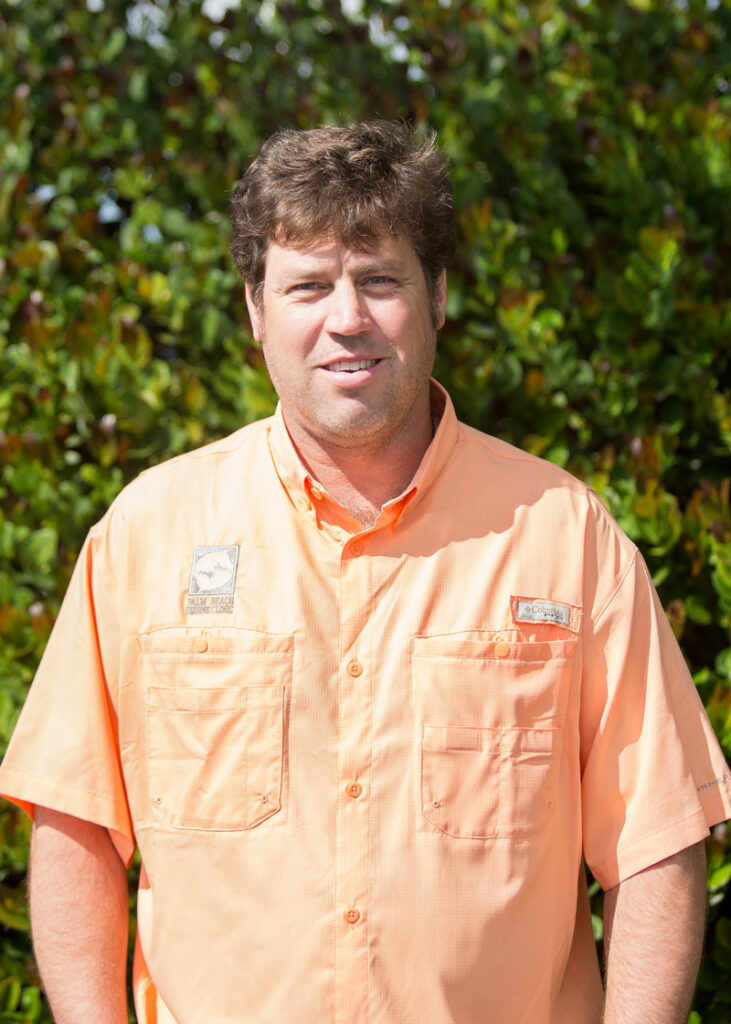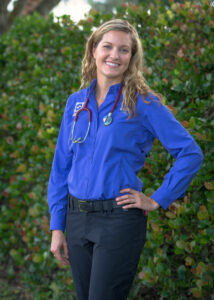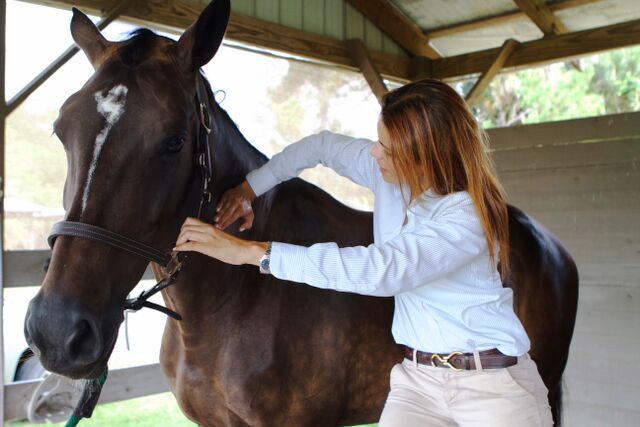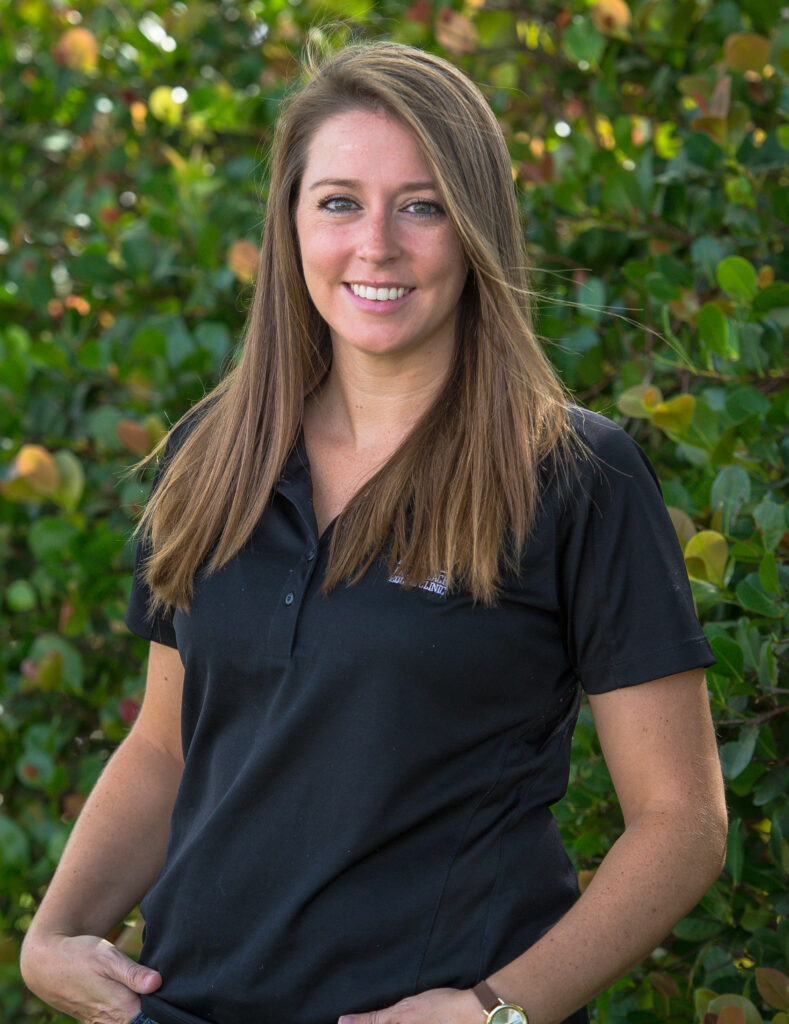Author: pbecadmin
At first glance, Dr. Santiago Demierre appears to be a young veterinarian making a name for himself in the field of equine medicine. A closer look, however, reveals that he is not only that but also an exceptional example of diligence; he’s also working to become an extraordinary veterinarian while speaking a second language all in a country that is 5,000 miles from his home.
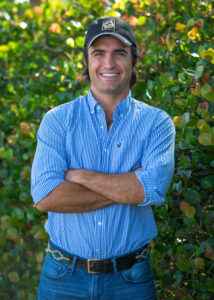
Born in San Antonio de Areco, a small town in the countryside outside Buenos Aires, Argentina, Dr. Demierre is now a 32-year-old veterinarian working with some of the most cutting-edge veterinary technology in the industry at Palm Beach Equine Clinic (PBEC) in Wellington, FL. He attended vet school at Universidad de Buenos Aires and graduated as Medico Veterinario in 2012 before setting a goal to validate his degree in the U.S. While mastering the English language, he enrolled in a certification program called the Educational Commission for Foreign Veterinary Graduates (ECFVG) through the American Veterinary Medicine Association and officially validated his degree in the U.S. in January 2017.
Today, Dr. Demierre is one of 40 veterinarians on staff at PBEC, which includes six boarded specialists and more than 80 technicians and staff members, making it one of the largest sport horse practices in the world.
Three things you may not know about Dr. Santiago Demierre:
1. Horses are in his blood.
Dr. Demierre: My father was a racehorse breeder and trainer, so while I was growing up I spent hours with him and the horses at the farm. I was always very interested in animals in general, not only horses, so even as a little kid I had the idea and the dream that I would be a veterinarian in order to be able to spend as much time with animals as I could. Now, I enjoy so many things about this work, but what really motivates me is the satisfaction I feel when I have a successful outcome on a case.
2. When the opportunity came to study veterinary medicine, he picked up and moved across the world.
Dr. Demierre: A fellow veterinarian who is a friend of mine, Dr. Eduardo Beccar Varela, contacted me with his nephew Dr. Axel Beccar Varela, who is a board-certified surgeon, and they offered me an externship at the clinic where he was practicing in Florida. I took that opportunity and began working in the U.S.
While here, a friend of mine, Gringo Colombres, introduced me to Dr. Scott Swerdlin, president of PBEC. He offered me an internship at PBEC in Wellington and I am now in my fourth season there.
The team at Palm Beach Equine Clinic is made up of great veterinarians and now great friends. There is always somebody from whom you can learn something new every day. Also, it is awesome to be in contact with the world’s top equine athletes. That is what I enjoy most about being part of the team at PBEC—working on performance horse cases. More specifically, I really like preventing and treating lameness in sport horses.
3. True to his Argentinian roots, he does some riding himself.
Dr. Demierre: I love being outdoors. When I am not treating patients or at the clinic, you can probably find me riding polo ponies. If I’m not there, I am either fishing, hunting, or enjoying some time off with my girlfriend.
Even after treating patients in both Argentina and North America, Dr. Demierre’s trans-continental bucket list is far from fulfilled. Next, he hopes to take the skills he has mastered at PBEC and validate his degree in Europe as well.
Want to learn more about the veterinarians of PBEC and what they have to offer your equine athlete or backyard companion horse? Call the clinic today at 561-793-1599 to learn more.
Internal Medicine: What’s it all about?
Palm Beach Equine Clinic President Dr. Scott Swerdlin often says, “If you want to attract equine veterinary specialists, you have to have impressive facilities and technology in place.” Palm Beach Equine Clinic is one of the few veterinary clinics in the country to offer clients the talents of board-certified specialists in nearly every branch of equine veterinary medicine. One such specialist is Peter Heidmann, DVM, DACVIM, a graduate of Tufts University School of Veterinary Medicine, who joined Palm Beach Equine Clinic in 2016.
Dr. Heidmann specializes in the treatment of internal medicine cases at Palm Beach Equine Clinic.
What attracted him? The facilities! In the heart of South Florida’s horse country and at the center of the busiest winter competition schedule in the world, Palm Beach Equine Clinic boasts an internal medicine and infectious disease center at its Wellington-based clinic.
The crown jewel of the center is the ability to stop airborne disease dead in its tracks with the U.S. Department of Agriculture (USDA) approved isolation stalls that completely enclose horses in their own environment with individual filtered airflow systems that do not reach other horses. On top of secure isolation and individual airflow systems in their internal medicine facilities, Palm Beach Equine Clinic also constructed areas for each stall where medications are prepared, equipment is stored, and dirty bedding is handled.
To further mitigate risk, veterinarians, technicians, and staff take every available precaution, including foot baths before entering the stalls and wearing personal protective equipment such as Tyvek suits, gowns, and face masks to provide multiple layers of protection against spreading disease. In some cases, a specific team of doctor, technician, and intern is assigned to a patient and won’t touch another horse for the duration of the treatment.
Accurately Diagnosing Internal Medicine Cases
Diagnostics is not a guessing game at Palm Beach Equine Clinic. With advanced imaging equipment, including a computed tomography (CT) machine, standing magnetic resonance imaging (MRI), and nuclear scintigraphy camera (bone scan), as well as radiography (x-ray) and ultrasonography capabilities, Palm Beach Equine Clinic is armed and ready to quickly and accurately diagnose internal medicine cases.
Dr. Heidmann refers to the facilities and his work at Palm Beach Equine Clinic as a luxury, saying, “I’ve managed many cases in various facilities going all the way back through internship, fellowship, and residency, but this is as nice as any place I have ever worked. It makes the risk to the horses so much lower, but also removes the anxiety for myself because I’m able to look a client in the eye and tell them that there is no risk. I don’t have a concern about disease spreading from one patient to another because at Palm Beach Equine Clinic we have the tools that we need.”
Understanding Internal Medicine
To understand how diagnostic tools are most effective, one must understand what exactly internal medicine is. In an effort to define internal medicine, Dr. Heidmann noted, “What you’ll see on the American College of Veterinary Internal Medicine (ACVIM) website is an emphasis on organ systems and organ system problems – respiratory disease, gastrointestinal disease, and neurologic disease being three of the most prevalent.
“What it really entails is a way of analyzing problems specific to the organ systems,” he continued. “It can be all over the map, and that’s part of what makes the specialty so fun and interesting.”
The most common internal medicine cases can be split into three categories:
- gastrointestinal (GI) problems
- neurological system issues
- respiratory diseases.
Gastro-Intestinal Problems in Horses
“When it comes to GI issues, I usually see horses in two categories,” said Dr. Heidmann. “Number one are the horses that may need to go to colic surgery and the horses that just had colic surgery. The other is horses with intestinal infections, often colitis in which they have heavy diarrhea.”
According to Dr. Heidmann, all of the treatments for colitis tend to boil down to the same thing: replacing their ongoing losses and letting the intestine heal itself. It doesn’t matter if it’s colostrum, salmonella, Potomac Horse Fever, or any other kind of infection.
Equine Neurologic System
The nervous system in a horse is made up of the brain, spinal cord, and several different kinds of nerves that are found throughout the body. These create complex circuits through which animals experience and respond to sensations. Unfortunately, many different types of diseases can affect the nervous system, including birth defects, infections, inflammatory conditions, poisoning, metabolic disorders, nutritional disorders, injuries, degenerative diseases, or cancer.
“Palm Beach Equine Clinic has an incredible ability to do advanced imaging and diagnostics on neurologic conditions,” said Dr. Heidmann. “With equipment like the standing CT, we can do scans of the head and neck with contrast – a CT myelogram – which really increases our ability to diagnosis a condition.”
Palm Beach Equine Clinic is able to locate problems not only on the top or bottom of a horse’s neck, but also on the sides of the neck – an area previously inaccessible to view even from myelograms under anesthesia.
“That’s part of the satisfaction of the job that I do; It’s not just ‘here is my experience and here is what I guess is going on.’ I have all of these options at my fingertips for diagnostics and tests. We can confidently confirm our clinical suspicions and then do treatment based on that.”
Respiratory Disease in Horses
As common as a cold for a human or acute in nature, Dr. Heidmann further breaks down the different kinds of common respiratory disease in horses into three categories:
When Margo Crowther of Fort Myers, FL, was looking to add a new addition to her string of barrel racing horses, she made one very important phone call. That first call was to Palm Beach Equine Clinic (PBEC). Dr. Weston Davis, board-certified surgeon and veterinarian at PBEC, has been working with Crowther for several years and has helped maintain her horses and even performed some career-saving procedures.
In 2016, Dr. Davis helped Crowther and her 2012 Quarter Horse mare Shes Packin Fame or “Sissy” return to the ring after what could have been a detrimental injury. Sissy suffered a rare slab fracture to the central tarsal bone in her left hock while competing in a barrel racing competition. After a diagnosis aided by PBEC’s state-of-the-art diagnostic imaging equipment and a surgery performed by Dr. Davis, Shes Packin Fame not only returned to running barrels, but the five-year-old mare was also back to winning the next year. Click here to learn more about Sissy!
Crowther Meets “Mater”
This time, Crowther turned to Dr. Davis to ensure that her intended purchase of a new horse was a good fit. When she met Grandiose Guy, known to her as “Mater,” she had to have him. The Quarter Horse gelding was named the Barrel Futurities of America (BFA) Horse of the Year just after she purchased him in 2017, crowning him the top four-year-old in the country.
“When I was thinking about buying him, I called Dr. Davis and sent him videos of the horse working to review,” said Crowther, who started the purchase process late last year. “The horse was in Georgia, so he reviewed them from PBEC in Wellington and gave me the stamp of approval. Once a pre-purchase was performed, I sent all the x-rays to Dr. Davis and he told me to move forward.
“I trust Dr. Davis and the team at PBEC so much!” continued Crowther. “Barrel horses work hard and it’s so important to have a great relationship with the veterinarian who oversees their care and knows them well in order to keep them happy and healthy.”
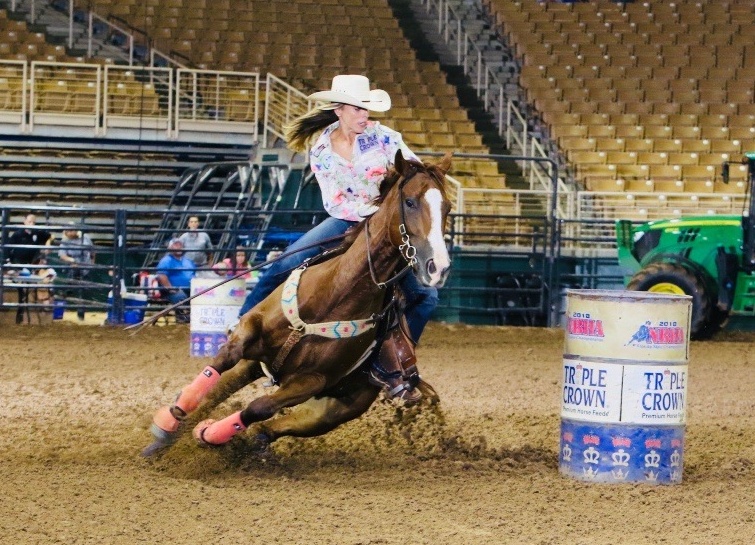
Crowther purchased Mater and started running him at the start of 2018, bringing him to the largest one-day rodeo, The American, in the Dallas Cowboys stadium in Texas in February. The competition had a $1 million payout and Mater and Crowther placed fifth.
“After so many runs, we brought him home from Texas and got him over to Dr. Davis for any maintenance work that needed to be done to keep him feeling his best,” said Crowther. “I am very picky about where I take my horses; there has to be good ground and I will not run their legs off. In conjunction with that, maintenance work with Dr. Davis is important. He performs flexion tests, utilizes the imaging at PBEC if necessary, and makes recommendations about my horses’ health and overall well-being.”
Dr. Davis sent Mater home from PBEC with a clean bill of health and Crowther gave the gelding a little time off before their next run. After returning to work, Mater headed to the National Barrel Horse Association (NBHA) Florida State Championships in Kissimmee in mid-June.
Success for Crowther and Mater
Crowther’s diligence and Dr. Davis’ knowledge paid off in full when Mater won both his runs and clinched the open final at NBHA Florida State Championships. With more than 700 entries, Mater and Crowther topped them all and were crowned overall champions of the event.

“PBEC and Dr. Davis have been a huge part of the success I have had with all of my horses,” said Crowther. “They are always there when I need them, whether I’m headed to the clinic or they are coming to me in Fort Meyers. It’s nice to be able to know your vet will be there for you whenever you need them.”
Palm Beach Equine Clinic (PBEC) is changing the prognosis for condylar fracture injuries among sport horses. Advances in imaging, surgical talent, and the facilities necessary to quickly diagnose, treat, repair, and rehabilitate horses with condylar fractures have recently improved immensely.
Most commonly seen in Thoroughbred racehorses and occasionally polo ponies, a condylar fracture was once considered a career-ending injury. Today, however, odds are in favor of a full recovery with horses regularly returning to competition in their respective disciplines.
What is a Condylar Fracture?
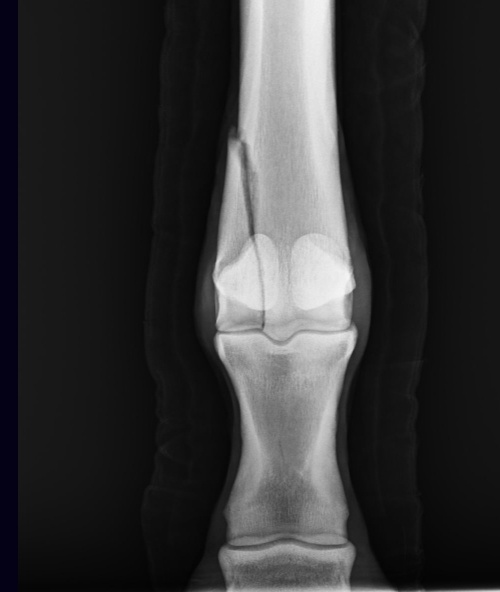
A condylar fracture is a repetitive strain injury that results in a fracture to the cannon bone above the fetlock due to large loads transmitted during high-speed exercise. 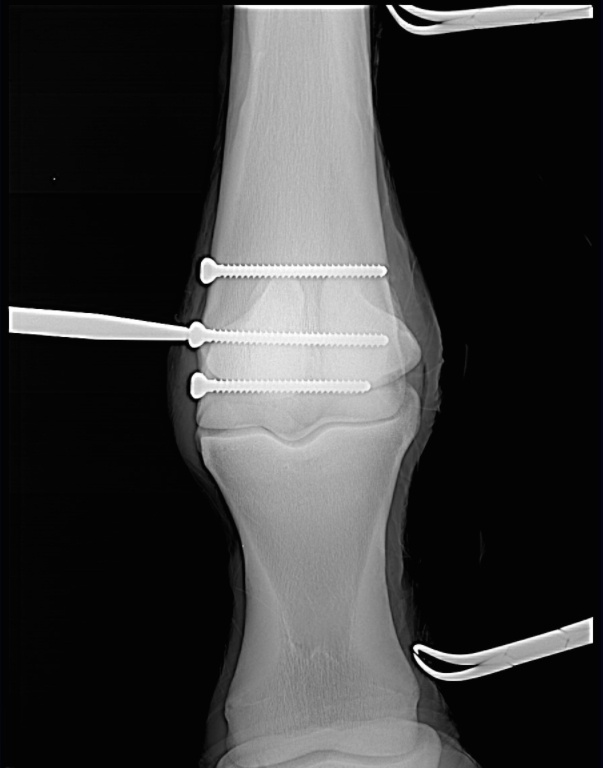
Scan showing the screws inserted during surgery (right). This patient, a Thoroughbred racehorse, walked away from surgery comfortably and is recovering well.
A condylar fracture is a repetitive strain injury that results in a fracture to the cannon bone above the fetlock due to large loads transmitted over the cannon bone during high-speed exercise. On a radiograph, a condylar fracture appears as a crack that goes laterally up the cannon from the fetlock joint and out the side of the bone, essentially breaking off a corner of the cannon bone, sometimes up to six inches long.
“A condylar fracture is a disease of speed,” said Dr. Robert Brusie, a surgeon at PBEC who estimates that he repairs between 30 and 50 condylar fractures per year. “A fracture to the left lateral forelimb is most common in racehorses as they turn around the track on a weakened bone and increased loading.”
Condylar fractures are further categorized into incomplete and non-displaced (the bone fragment hasn’t broken away from the cannon bone and is still in its original position), or complete and displaced (the fragment has moved away from the cannon bone itself and can often be visible under the skin).
Additionally, condylar fractures can occur laterally or medially. According to fellow PBEC surgeon Dr. Weston Davis, most condylar fractures tend to be lateral on the outside condyle (a rounded projection on a bone, usually for articulation with another bone similar to a knuckle or joint).
“Most lateral condylar fractures are fairly simple for us to fix,” said Dr. Davis. “Medial condylar fractures tend to be more complicated configurations because they often spiral up the leg. Those require more advanced imaging and more advanced techniques to fix.”
What is the Treatment?
The first step in effectively treating a condylar fracture through surgery is to accurately and quickly identify the problem. PBEC’s board-certified radiologist Dr. Sarah Puchalski utilizes the advanced imaging services at PBEC to accomplish exactly this.
“Stress remodeling can be detected early and easily on nuclear scintigraphy before the horse goes lame or develops a fracture,” said Dr. Puchalski. “Early diagnosis of stress remodeling allows the horse to be removed from active race training and then return to full function earlier. Early diagnosis of an actual fracture allows for repair while the fracture is small and hopefully non-displaced.”
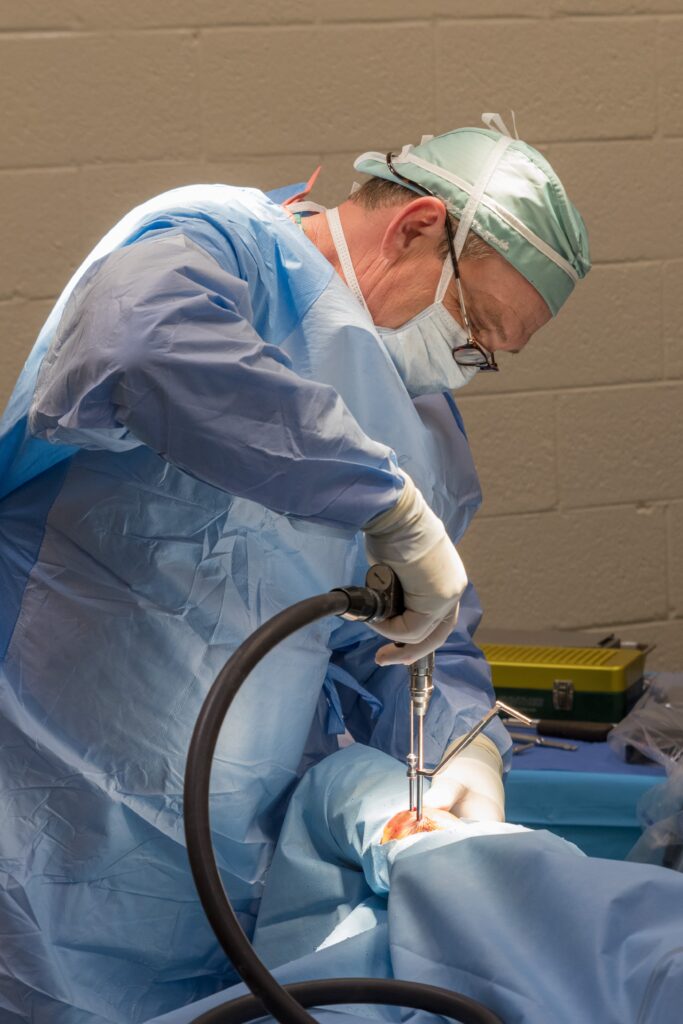
Once the injury is identified as a condylar fracture, PBEC surgeons step in to repair the fracture and start the horse on the road to recovery. Depending on surgeon preference, condylar fracture repairs can be performed with the horse under general anesthesia, or while standing under local anesthesia. During either process, surgical leg screws are used to reconnect the fractured condyle with the cannon bone.
“For a very simple and small non-displaced fracture, we would just put in one to two screws across the fracture,” explains Dr. Davis. “The technical term is to do it in ‘lag fashion,’ such that we tighten the screws down heavily and really compress the fracture line. A lot of times the fracture line is no longer visible in x-rays after it is surgically compressed. When you get that good compression, the fractures heal very quickly and nicely.”
More complicated fractures, or fractures that are fully displaced, may require more screws to align the parts of the bone. For the most severe cases of condylar fractures, a locking compression plate with screws is used to stabilize and repair the bone.
PBEC surgeon Dr. Jorge Gomez, approaches a simpler non-displaced condylar fracture while the horse is standing, which helps to aid in a faster recovery and more successful surgical outcome.
“I will just sedate the horse and block above the site of the fracture,” said Dr. Gomez. “Amazingly, horses tolerate it really well. Our goal is always to have the best result for the horse, trainers, and us as veterinarians.”
According to Dr. Gomez, the recovery time required after a standing condylar fracture repair is only 90 days. This is made even easier thanks to a state-of-the-art surgery pit installed at PBEC. The four-and-a-half-foot recessed area allows doctors to perform surgeries on anything from a horse’s hock and below from a standing position. Horses can forgo the risks of general anesthesia for a mild sedative and local nerve blocks, greatly improving outcomes.
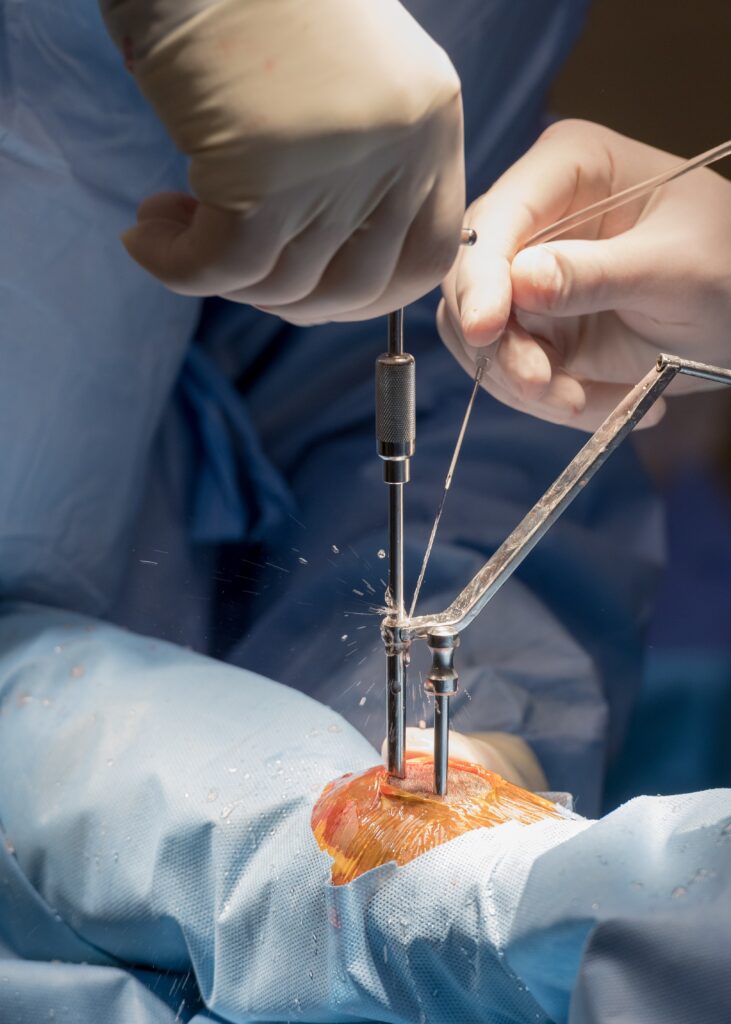
“A condylar fracture was once considered the death of racehorses, and as time and science progressed, it was considered career-ending,” concluded Dr. Brusie. “Currently, veterinary medical sciences are so advanced that we have had great success with condylar fracture patients returning to full work. Luckily, with today’s advanced rehabilitation services, time, and help from mother nature, many horses can come back from an injury like this.”
Success Story: Ameloblastic Fibroma
When a middle-aged mare with a mysterious mass in her mouth came under the care of Palm Beach Equine Clinic in Wellington, FL, Dr. Weston Davis pulled out all the stops to find a definitive diagnosis. The oral mass was growing at a rapid rate and was positioned just behind the bottom incisors on the left bar of the horse’s mouth.
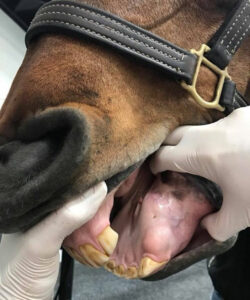
A view of the oral mass being examined by Dr. Davis.
Computed Tomography Imaging
First, Dr. Davis turned to the use of PBEC’s state-of-the-art computed tomography (CT) machine to obtain an image of the mass and its exact location within the horse’s mouth. Then, a surgical biopsy was performed and the histopathology, or microscopic examination of the biopsied tissue, revealed the manifestation of an ameloblastic fibroma. An ameloblastic fibroma is a mixed odontogenic (dental) tumor composed of soft tissues.
“Although this tumor type rarely metastasizes, it tends to be locally invasive and aggressive, requiring the complete removal and/or aggressive radiation therapy,” said Dr. Davis, who is a board-certified surgeon at PBEC.
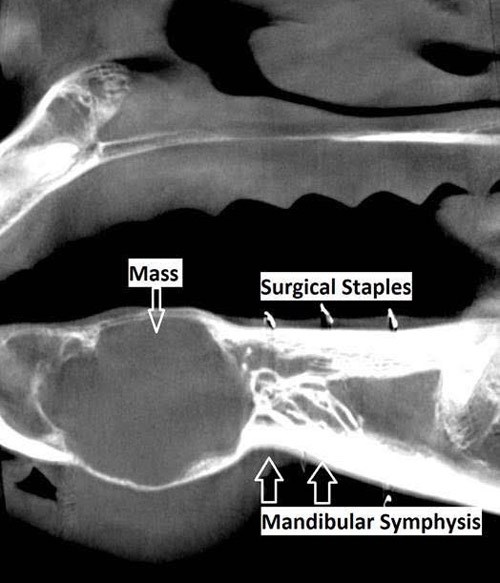
Ameloblastic Fibroma Treatment Plan
A tumor of dental origin is rarely found in humans and is extremely rare in equines, but upon diagnosis, Dr. Davis quickly identified a treatment plan, saying, “In this case, the CT mapping that was performed enabled us to completely remove the tumor via a rostral mandibulectomy with preservation of the mandibular symphysis (the joint between the two halves of the mandible).”

The horse underwent surgery at PBEC and Dr. Davis removed the tumor along with the rostral (front) mandible, which includes the lower incisor teeth and essentially the entire front portion of the lower jaw of the horse.
The obvious question that arises from a rostral mandibulectomy is “how effectively will the horse be able to eat without bottom teeth?” For this patient, however, the answer came quickly and it was nothing short of encouraging. The mare returned to eating just hours after surgery and, at her two-week checkup with Dr. Davis, was back on a normal diet of hay, grain, and – of course – treats.
According to Dr. Davis, the majority of animals that undergo this type of surgery often compensate well and have little trouble eating. For this mare, her only struggle in the future may be the prehension of very short and/or tough pasture.

A view of the lower lip of the horse after surgery. 
Two weeks post-surgery and no visible signs of a rostral mandibulectomy.
Post Mandibulectomy Surgery
Also at two weeks post-surgery, Dr. Davis approved the mare for light riding activity with a hackamore. The mare competed in the jumper ranks before surgery and at a four-week checkup, Dr. Davis gave the all-clear and the mare returned to full work. She even made a comeback in the competition ring at Palm Beach International Equestrian Center with very little visual evidence that a mandibulectomy was ever performed.
“This was a rare tumor and a rare surgery, but the horse recovered incredibly well and fast!” said Dr. Davis. “It was an excellent patient outcome. “I gave her the all-clear at four weeks post-surgery and she is already back to winning classes.”
All Photos Courtesy of Dr. Weston Davis
Meet PBEC Veterinarian Dr. Marilyn Connor
For some, becoming an equine veterinarian was always their calling. But, for Palm Beach Equine Clinic’s own Dr. Marilyn Connor, a diverse education and a healthy serving of life experience gave her options. Originally hailing from just north of Dallas, TX, Dr. Connor grew up around horses, but initially set her sights on going to medical school to study human medicine. Her undergraduate studies started at Tulane University in New Orleans, LA, before she transferred back to her home state of Texas to graduate in 2006 with honors from Texas A&M University with a Bachelor of Science degree in biomedical science and minors in chemistry and business.
After conducting a Master’s level research project on the effects of social stress on an animal model of multiple sclerosis, Dr. Connor broadened her horizons and moved to New York. While in New York, Dr. Connor spent three years as a research analyst and junior stock trader at a New York-based hedge fund. On her weekends, Dr. Connor volunteered at a therapeutic riding program in Brooklyn, NY, where she taught riding lessons to children, adults, and veterans. It was during her time volunteering at the therapeutic riding program, that Dr. Connor realized she wanted a career where she was able to help both people and animals. Ultimately, this passion lead her back to Texas where she attended four years of veterinary school at Texas A&M University.
Here’s the rest of Dr. Connor’s story
What led you to an internship at PBEC?
In veterinary medicine, unlike human medicine, it is optional to complete an internship after graduation before going into practice. It’s estimated that by completing an equine internship, because of the high caseload and number of hours worked, you gain anywhere from three to five years of experience. Because I was a non-traditional vet student, with a career before I started vet school, I really wanted to jumpstart my career so I could become an experienced veterinarian quickly. I felt that completing an internship was a good investment of my time, so I could get those additional hours of mentorship and become a excellent veterinarian. I considered many of the best practices in the country, mostly in California and Colorado, when searching for an internship. I met Dr. Swerdlin at an American Association of Equine Practitioners conference in Las Vegas two years ago and he invited me to come to Palm Beach Equine Clinic for a visit. I fell in love with the practice and the people, and felt the internship offered a good balance of autonomy to act as a doctor while still providing mentorship for a young veterinarian. One thing that’s unique about PBEC is that we have a full staff of technicians day and night so I knew, as an intern, I would be able to rest in the evenings so I could focus my time on learning and becoming a good veterinarian. In some practices, interns are expected to act as a doctor during the day, but at night they are required to come to the hospital to feed horses, cleaning stalls, or administer simple medications which could be done by a technician. Another big motivation for me was that we have so many doctors to collaborate with. During the peak of season, there are roughly 40 doctors here to learn and gain experience from. I was also impressed with the very diverse case load that comes into PBEC. Those are some of the reasons I joined PBEC as an intern in July 2017.
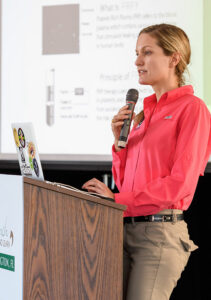
What is your experience with horses outside of being a veterinarian?
I like to say that I was riding horses since before I was born. My mom had horses and she rode while she was pregnant with me. When I was eight I got my first horse and rode western; mostly trails, pleasure, and a little bit of barrels, until I was twelve. Then I switched over to English riding and showed in both the Hunter and Jumper divisions until I was 18 and left for college. I didn’t have the means to bring a horse with me to school, so there was a period of about two years when I was only riding when I would come home.
During my sophomore year of college, I got a job at a barn exercising and training first and second-level dressage horses. Later in college, I had a friend who did competitive endurance racing and she had some spare horses that she needed ridden in competition so I did that and it’s something that I stayed with until today. As you can see, I have just about done it all when it comes to riding. I also have trained young horses and taught riding lessons since I was about 15 years old. After college, I spent some time teaching at a therapeutic riding center and this was one of the things that ultimately made me realize I wanted to be an equine veterinarian so that I could help both horses and the people that love them.
What is your typical day like at PBEC?
One of the things I love about being a veterinarian, is that no two days are the same! Most days, I come into the hospital first thing in the morning to, physical examinations and treatments on my hospitalized patients that are staying at PBEC. On some days, I manage anesthesia for the surgeries taking place at the clinic, so I must make sure the patient is physically healthy enough to handle anesthesia and undergo surgery. I then administer a combination of medications to induce and maintain them under general anesthesia for the surgery. I monitor them throughout the procedure and stay with them until they have fully recovered after surgery and are able to stand up and walk back to their stall. I am happy to report I will be staying on at Palm Beach Equine as an associate, so I am working on developing my client base within the clinic. now I make farm calls to see my patients and I also seeing many of the call-in appointments for routine veterinary care as well as daytime emergencies such as when people discover their horse has an injury or is sick. I have taken continuing education courses that are specific on dentistry, so I also see patients that require dental care such as having their teeth floated. I am also certified in veterinary chiropractic, so that’s another service that I bring to the clinic.
What’s your favorite kind of case to work on?
I like so many things about my job, but I really like helping my clients to maximize the health of their horses through nutrition, wellness care, and preventative medicine. I also like working with lameness in horses; diagnosing orthopedic conditions and treating them with a combination of traditional joint injections, regenerative medicine, rehabilitation, and alternative medicine. It’s very rewarding to help my equine patients to be able to do their job at a high level and stay sound. I also enjoy working with clients to understand things they can do to prevent their horse from needing those kind of interventions later on in life.
I do a lot of the veterinary care for the Vinceremos Therapeutic Riding Center, which PBEC supports. It is very rewarding to be able to give back to a cause that is important to me, but now in a different capacity as a veterinarian.
What do you enjoy most about working for PBEC?
One thing I enjoy about working at PBEC is that we are well-equipped with the most advanced technology and equipment rarely offered outside of a university setting. We have an amazing hospital facility, top quality surgeons, the latest in regenerative medicine, and the most advanced diagnostic tools including radiography, MRI, nuclear scintigraphy and our new Computed Tomography (CT) machine, which very few practices have. As a doctor, it is amazing to have every tool at my disposal, so I can provide the best quality veterinary care for my patients. But I think my favorite thing about working at PBEC and what really makes us unique as a practice is that we have an exceptional team of doctors with different backgrounds and slightly different skill sets. While every doctor essentially operates autonomously within the practice, it is still one big team. I have so many doctors I can call day or night if I am stumped on a case or need assurance that the treatment plan is appropriate. At PBEC we always collaborate to provide the best quality care for our patients.
When Grand Prix dressage rider Meagan Davis needs to make sure her horses are feeling their best, she turns to Palm Beach Equine Clinic, located in the heart of Wellington, FL. Palm Beach Equine Clinic has invested more than 30 years and the work of talented veterinarians in evolving the most advanced diagnostic imaging, surgical skills, alternative therapies, and overall care of sport horses across varying disciplines.
Meagan Davis Dressage, based in Loxahatchee, FL, and Stone Ridge, NY, has entrusted Palm Beach Equine Clinic with the care and maintenance of their string of dressage horses for nearly a decade. Drawn to the personalized care provided by Palm Beach Equine Clinic’s team of veterinarians, which includes six boarded specialists, head trainer Davis was immediately comfortable turning to the clinic for the care of her horses.
“Palm Beach Equine Clinic is the premier facility in South Florida,” said Davis, 28, who has been traveling to Florida to compete at events that include the prestigious Adequan® Global Dressage Festival since she was 18 years old. “If I am going to have a horse undergo any kind of surgery or maintenance work, I will choose Palm Beach Equine Clinic every time without a doubt.
“Knowing that I can compete well in a CDI because my horse is feeling his best gives me valuable peace of mind,” said Davis. “Being that we have a couple of older horses, maintenance is huge in keeping their longevity. We have a 19-year-old horse who could go out and compete fourth level tomorrow because he is so well cared for by our vets. For my younger horses, it’s about keeping them feeling their best so their careers are as long as these older horses we have.”
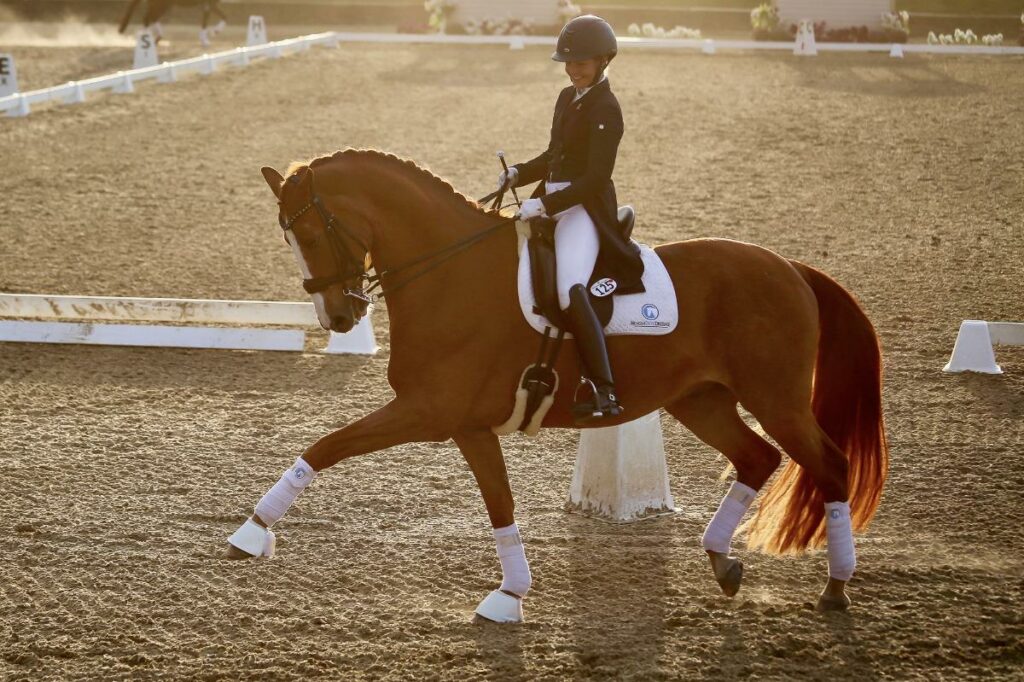
A Quick Look at Meagan Davis Dressage
Davis herself competed internationally for the first time at age 11 in the FEI Pony Division at the America’s Cup in Blainville, Quebec, while riding under the tutelage of U.S. dressage rider Lendon Gray. The appearance earned her the distinction of being the youngest rider to represent the United States in international dressage competition. She won the USEF National Young Rider Dressage Championship in 2010 and went on to compete at the Young Rider World Cup in Frankfurt, Germany, that same year. There, Davis earned a title as the only U.S. rider to finish in the “A” final, where she was seventh.
Davis later rode under the direction of 2004 Olympic and 2006 FEI World Equestrian Games team gold medalist Hubertus Schmidt of Germany before launching her own business at the end of her junior career.
“I built the business up from there,” said Davis. “I got a couple low level green broke horses to start and continued their education up through the levels. Clients started to see us at shows and were coming to me.
“When I turned 21, I started to bring clients down to Florida with me,” continued Davis, who runs her boarding and training operation out of a Loxahatchee farm owned by her parents, Bill and Karen Davis.
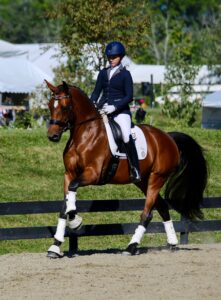
Davis currently oversees the care and training of 14 horses ranging in age from three to 23. Her own mount Royale, owned by longtime client Scott Durkin of New York, NY, is currently competing in the small tour division and contested five CDI events during the 2018 winter season. Davis is also currently producing a young horse, Damocles HLF, which her father found at an auction in Orlando. At only eight, the gelding is competing in the Developing Prix St. Georges ranks.
Davis also has a three-year-old gelding she is starting herself for Durkin, as well as clients competing at second and third level. There is even a dressage pony rounding out the string!
Trusting Palm Beach Equine Clinic
For Davis, the correct maintenance of the horses under her supervision is the cornerstone of her training program.
Palm Beach Equine Clinic’s own Dr. Robert Brusie, who graduated from Michigan State University College of Veterinary Medicine and is a board-certified surgeon, pays a visit to Meagan Davis Dressage when they arrive at their southern base each November. Giving all the horses a comprehensive exam, Dr. Brusie evaluates the needs of each individual horse to keep them fit and happy during the show season.
“He does a full work-up – flexions, injections, x-rays if needed,” said Davis. “There was a time when we weren’t doing these checks and what would happen is we would get going and I would find that something didn’t feel right and we would be missing shows during the season.”
Dr. Brusie is also responsible for vetting the majority of Davis’ horses. One, in particular, was a 14-year-old Westphalian who had a late flying change.

“We discussed how the flying change was so late and if we would ever be able to fix that situation,” said Davis. “Dr. Brusie watched the horse go, I schooled the flying changes for him, we did the vetting, and he said, ‘You’ll have this change no problem.’ He gave me what he thought would be a good program for maintenance and muscle building and the next year we had changes. I competed him through fourth level.”
When the Unexpected Happens
Every horse owner knows that when it comes to a horse’s health, the unexpected is always a looming possibility. For Davis, however, the anxiety of caring for top level sport horses is slightly assuaged by having PBEC in her corner.
“We have a Friesian who was losing weight with no clear reason why,” said Davis. “I was referred to Dr. Heidmann, who was able to correctly diagnose a colon ulcer over the phone after listening to his symptoms. He told me exactly what to do and the horse was almost magically better!”
Dr. Peter Heidmann is the PBEC resident internal medicine specialist and rounds out a diverse group of veterinarians and specialists who provide comprehensive diagnostic and treatment care.
“It’s nice that they have such a wide variety of vets on staff,” continued Davis. “We have used their MRI machine to help diagnose a torn check ligament on a horse that has since made a full recovery and is back to work, we have had them quickly assess a minor colic that had the potential to be very serious, and we have had PBEC vets here for everything from gelding stallions to teeth floating.”
With the care of her horses always at its best, Davis has big plans for her clients and herself, saying, “I hope to move Royale up to the Grand Prix level in the next year, and I would love to qualify Damocles for the USEF Young & Developing Horse Dressage National Championships. As for the clients, they will all be qualifying for regionals, which is a big deal for adult amateurs at second level. It’s all made possible because Palm Beach Equine Clinic keeps all of our horses feeling their best.”
Have further questions about the services available at Palm Beach Equine Clinic? Call the clinic today at 561-793-1599 to learn more.
Whether it’s for an Olympic hopeful or a reliable trail horse, Palm Beach Equine Clinic has more than 30 years of proven success keeping horses healthy and happy while working to extend their performance careers. In addition to innovative veterinary services that utilize advanced diagnostic tools and surgical equipment, Palm Beach Equine Clinic also offers alternative therapies to optimize health and increase the longevity of the horse’s performance career.
Veterinary chiropractic manipulation, acupuncture, and Chinese herbal medicine are three alternatives to standard medical treatments offered at Palm Beach Equine Clinic. While all of Palm Beach Equine Clinic veterinarians are versed in the many aspects of equine medicine, several of the doctors have studied extensively in alternative therapies. Dr. Natalia Novoa treats horses with chiropractic manipulation and acupuncture, and Dr. Janet Greenfield-Davis focuses on acupuncture treatment and uses Chinese herbal medicine to bring out the best in her patients.
Alternative Therapies for a Competitve Edge

“The line between success and failure is very thin for performance horses, and a lot of these alternative therapies can be very useful in giving the horse that little bit more,” explained Palm Beach Equine Clinic’s Dr. Richard Wheeler. “Chiropractic and acupuncture are just two of the alternative therapies that we offer. They are both conjunctive therapies that can keep horses comfortable, happy and performing well.
“Both chiropractic manipulation and acupuncture can get the horse moving and feeling better, and help to maintain some minor chronic problems that they may have, therefore avoiding more invasive treatments,” Dr. Wheeler continued. “For neck or back pain, once we diagnose a problem, we may treat it and then follow up with a program of alternative therapies. These therapies are used with the aim of keeping the horse supple and moving with ease and helping the musculature to work correctly. We work with the trainers to optimize muscle development so that we can fix the problem and keep the horse moving forward and performing at their top level.”
Alternative Therapy: Equine Acupuncture
Fellow Palm Beach Equine Clinic veterinarian, Dr. Janet Greenfield-Davis is skilled in acupuncture and herbal medicine. Acupuncture is a form of treatment used in both traditional and classical Chinese medicine. It is based on the principle that there are energetic pathways, or channels, throughout the body that influence associated internal organs and structures. Energy from these pathways surfaces at various points on the body, identified as acupuncture points. Extremely fine gauge needles are inserted at selected points, stimulating these points and thereby activating the body’s natural healing abilities.
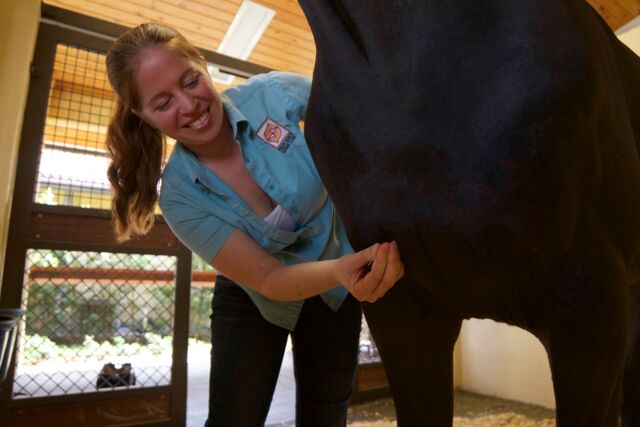
“We offer acupuncture, chiropractic and herbal medicine as an alternative or adjunct therapy to your current veterinary protocol,” Dr. Greenfield-Davis explained. “With acupuncture, we stimulate particular points that can relieve pain, increase endorphins, calm, and improve health and body function in horses. These specific points have a high capacity of nerve endings, lymphatic vessels, and blood vessels, as well as hormone stimulation.”
Clinical trials indicate that acupuncture may be an effective adjunct therapy for musculoskeletal problems such as muscle soreness, back pain, disc problems, osteoarthritis, and degenerative joint disease. Acupuncture may help neurological disorders such as laryngeal hemiplegia, and facial and radial nerve paralysis. It can help with gastrointestinal disorders including diarrhea, gastric ulcers, colic, and impaction. Acupuncture may also help with respiratory diseases, metabolic and endocrine diseases, and other chronic conditions, such as anhidrosis, heaves, asthma, cough, uveitis, and behavioral problems.
Alternative Therapy: Veterinary Chiropractic Manipulations
Alternative therapies such as acupuncture and chiropractic manipulation are increasingly popular amongst sport horse owners, and Palm Beach Equine Clinic’s Dr. Natalia Novoa offers both forms of treatment.
“Chiropractic adjustment is an excellent complementary modality that can be used for diagnosis, treatment, and prevention of selected neuromusculoskeletal disorders,” Dr. Novoa explained. “The practice of chiropractic focuses on the relationship between structure (primary spinal column) and function (coordinated by the nervous system) to restore it. The goal is to treat soft tissue injuries or articular dysfunction to optimize health through manual therapy and to detect and treat abnormalities and alleviate pain.”
Veterinary chiropractic manipulation is thought to optimize equine health by restoring the normal joint motion, reversing mild pathology, and helping to slow the progression of degenerative joint and spine disease. Over the years, this therapy has become a valuable adjunct for competition horses.
Chiropractic manipulation is also a great treatment option for horses that suffer neck and back pain, nerve damage, poor performance, behavioral problems, muscle spasms, localized or regional joint stiffness, unexplained lameness, gait abnormalities asymmetry/muscle imbalance/atrophy, injuries resulting from falls, trauma (such as slips, getting cast in the stall, or missteps), or poor fitting equipment.

“I identify the restricted movement or subluxations by manipulating and evaluating the joint mobilization. Then I restore the joint motion with an adjustment, which is a manually controlled force applied to a specific joint,” Dr. Novoa said of the process. Chiropractic and acupuncture therapies are complementary treatments for lameness problems and other issues. They are alternative methods and do not replace conventional veterinary medicine or surgery, but can be very useful in maintaining top performance levels in your horse.
“There has been an increase of interest in non-traditional therapy, and Palm Beach Equine Clinic is aware of its great value, so we provide the services to allow our horses to reach maximum performance potential and overall health,” Dr. Novoa concluded.
As sport horses become faster and stronger, veterinary medicine is often challenged to break barriers to provide the best in diagnostic and maintenance care. Palm Beach Equine Clinic is consistently on the forefront of those advances and employs a team of veterinarians equipped with the latest developments in regenerative medicine.
Two resources that have become increasingly popular to treat equine injuries are Platelet Rich Plasma (PRP) and Interleukin-1 Receptor Antagonist Protein (IRAP) to encourage regeneration of injured or degenerative tissue. Managing joint diseases and injuries using these methods is ground-breaking, but logical at their core. They essentially use naturally-occurring proteins, cells, and other natural bodily processes. Regenerative therapies put the horse’s own biological mechanisms to work stimulating healing without the use of steroids or other drugs.
What is PRP?
Platelets are among the very first cells to accumulate at an injured site, making them very important when simulating the repair process. Platelets contain granules filled with growth factors (the elements that aid in healing) and stimulate specified tissue to heal at an increased rate. To treat a horse with PRP, the veterinarians at PBEC are able to take a sample of the horse’s blood and concentrate the platelets in a high-speed centrifuge onsite. The harvest and processing procedure takes approximately 30 minutes before the concentrated platelet rich sample is injected back into the horse at the specific area of injury using sterile techniques and guided by ultrasound.
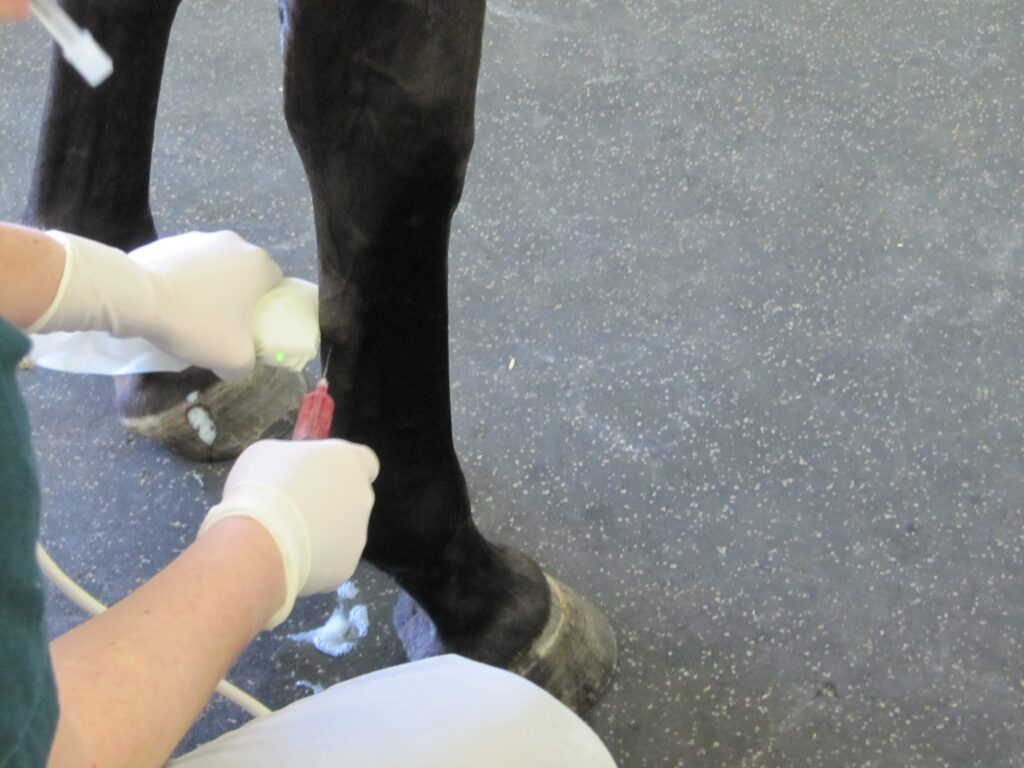
PBEC’s Board-Certified Staff Surgeon, Dr. Weston Davis, explained PRP use in more detail: “We harvest a large quantity of blood, anywhere from 60 to180 milliliters, and we process that to concentrate the segment that is very rich in platelets. We get a high concentration of platelets – we are hoping for five to eight times the concentration that you would get from normal blood. Then we take that platelet-rich extract and inject it back into an injured area to encourage a more robust healing response. Whenever you have an injury, platelets are one of the first cells that get there. They will aggregate, clump, and de-granulate. They release these granules, which are very rich in growth factors, and signal the body to start the healing process.”
What is IRAP?
IRAP is used to treat equine athletes that are susceptible to musculoskeletal injuries and osteoarthritis or degenerative joint disease. Joint trauma results in the release of inflammatory mediators such as Interleukin-1 (IL-1). IRAP uses a horse’s own anti-inflammatory protein found within the blood to counteract the destructive effects of IL-1 to slow the process of osteoarthritis. The process works by binding to the IL-1 receptors in the joint and blocking the continuation of damage and inflammation.
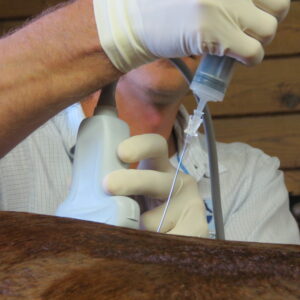
“We often see joint damage in sport horses because of the nature of their work, but we try to avoid overuse of steroids in joints because steroids can have long term effects on cartilage,” said PBEC veterinarian Dr. Samantha Miles. “This is a way we can manage joint disease and stop inflammation without having to consistently use steroids every time. Some of our clients will maintain their horses on IRAP alone for joint injections.”
The goal to better serve sports horses that continue to improve athletically is the driving force behind the development of even more developed and precise techniques used in regenerative medicine. And, at PBEC, the work to break new ground is never finished.
“I believe we are learning more about these technologies with more advanced science behind what they do and how they do it,” said Miles. “These treatments are natural, drug-free, and competition safe, and necessity drives the need for regenerative therapies in the sport horse world.”
Breeding the Modern Way
Palm Beach Equine Clinic’s Own Dr. Katie Atwood Discusses a 21st Century Take on Equine Reproduction
The process of breeding sport horses is ever-changing. Whether in an effort to produce the healthiest, most talented foals, to prolong the competition career of a mare, or make the most of a stallion’s longevity, reproductive science in horses has come a long way from the days of the traditional breeding shed.
Dr. Katie Atwood joined Palm Beach Equine Clinic, based in Wellington, FL, in June and brought her passion for reproductive work with her to the winter equestrian capital of the world.
“I like the creating of life,” said Dr. Atwood, who is a Florida native and University of Florida graduate and currently pursuing steps to become a board-certified reproductive specialist. “Equine medicine is intriguing, but you’re dealing with sick, unhealthy animals. With reproduction, I am working with healthy animals and making their babies, which I love!”
Embryo Transfer
The most popular wave of advancement that has hit the horse sport industry over the past several years is the process of embryo transfer.
How it works:
- A donor mare and stallion, who hold the genetics of the future foal, are bred.
- At seven or eight days of pregnancy, the embryo is flushed out.
- A catheter is placed through the vagina and cervix, and an inflatable cuff on the catheter provides a fluid-tight seal.
- A lavage fluid with surfactin (added to reduce the “stickiness” of the embryo and allow it to be extracted easily) passes down through a tubing system into the uterine lumen. As the fluid swirls throughout the lumen and drains back out through gravity, it collects the embryo, which is swept back out. The fluid and embryo pass out through the tubing system into and through an embryonic filter.
- When the embryo is identified under microscope, it is removed into a more enriched medium until the time of transfer.
- The embryo is shipped to a recipient farm where a young and healthy surrogate mare of decent size receives the embryo. That mare carries the foal to term, but it is genetically created from the donor mare and stallion.
While the process is fascinating, some may wonder why it’s necessary. According to Dr. Atwood, it relieves much of the concern owners have about breeding their sport horse mares.
“The gestation period for a horse is 11 months, so you’re only getting one foal per year when you breed traditionally,” she said. “This allows a mare to produce multiple foals per year, but it also allows that mare to remain in competition. This process can be done on younger mares with no interruptions to their competition and training schedules.”
Horses are now being bred at an ideal reproductive age while they are still in training, which is made even more valuable by the fact that advances in equine science has prolonged the longevity of horses. While 16 or 17 was once the age of an older horse, now it’s commonly seen as the age when horses are winning in the show ring. Thanks to embryo transfer, these horses can enjoy longer, healthy careers and still produce the talent of the future.
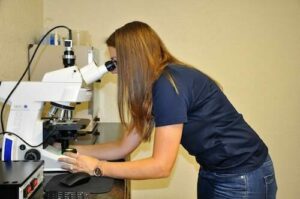
Dr. Atwood has seen embryo transfers become popular in dressage and polo, but she has begun to see it span all disciplines, saying, “At the start of the season, I had one farm and a few mares, but now it has quickly grown to several farms with multiple mares at each. It is really taking off because people now realize it does not remove their mares from competition.”
The process not only keeps mares competing, but it allows stallions to cross continents. Frozen fertilized embryos from working polo ponies in the U.S. are now being shipped to Argentina where they are carried by mares and then trained by some of the best polo trainers in the world. On the flip side, semen can also be frozen and shipped to the U.S.
“Stallions are collected, the semen is placed with an extender and high nutrient base so the sperm has something to use for energy, and then cooled slowly until it is frozen in liquid nitrogen,” said Dr. Atwood. “Once frozen, it is theoretically good forever. Last year, I bred a mare with 1991 semen and she was successfully pregnant!”
What’s Next at Palm Beach Equine Clinic
Palm Beach Equine Clinic underwent significant facility renovations over the last year, which included improvements to their onsite breeding shed. Now covered from the heat and inclement weather like an indoor arena, the shed boasts a hydraulic phantom mare.
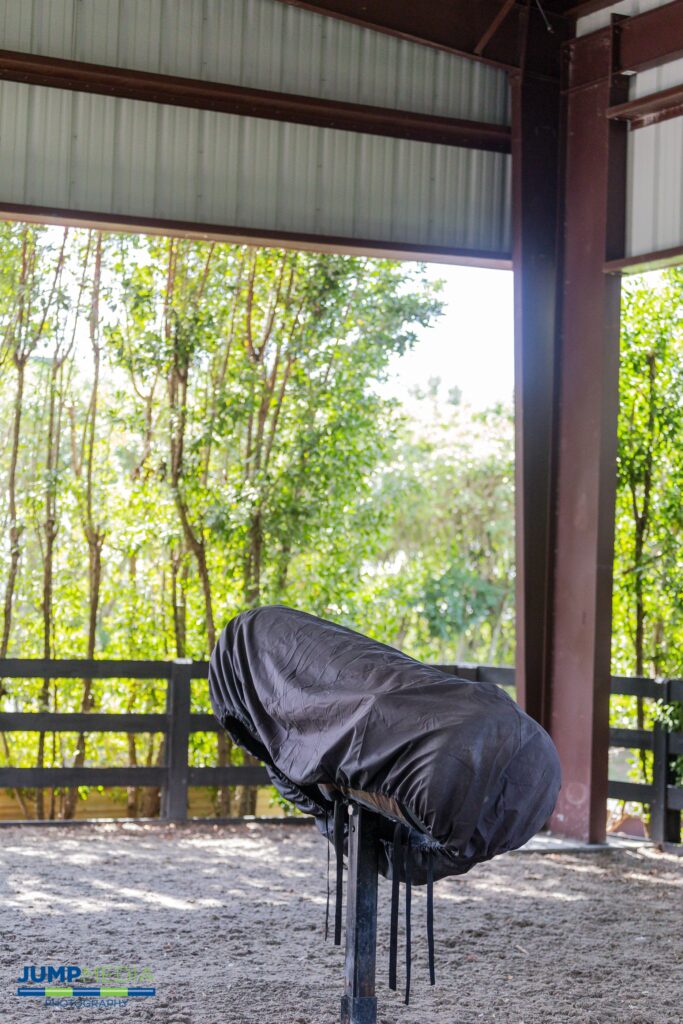
“We can raise a lower our phantom with the push of a button so it can be the appropriate for the stallion,” said Dr. Atwood. “Previously, we had to bring a tractor in to raise and lower the phantom.”
Additionally, Palm Beach Equine Clinic recently incorporated the use of a SCA® CASA (computer assisted sperm analyzer) system into their reproduction work. An excellent way to improve quality control of a stallion’s sperm, the system evaluates sperm motility (velocity and type of movement), concentration (sperm count), morphology (sperm shape), DNA fragmentation (counting of fragmented sperm), vitality (live and dead count) and acrosome reaction, which is what ultimately allows the sperm to penetrate the egg.
From onsite experience to computer technology, Palm Beach Equine Clinic offers Dr. Atwood the opportunity to be at the forefront of equine reproduction, a place she has always strived to be.
“I wanted to come into a practice that had a developed program in place, but what is even more important to me is mentoring and teaching my technicians and clients about reproduction,” she said. “It is so important to make sure these techniques are shared and promoted for the continued success of veterinarians, owners, and most of all horses.”
